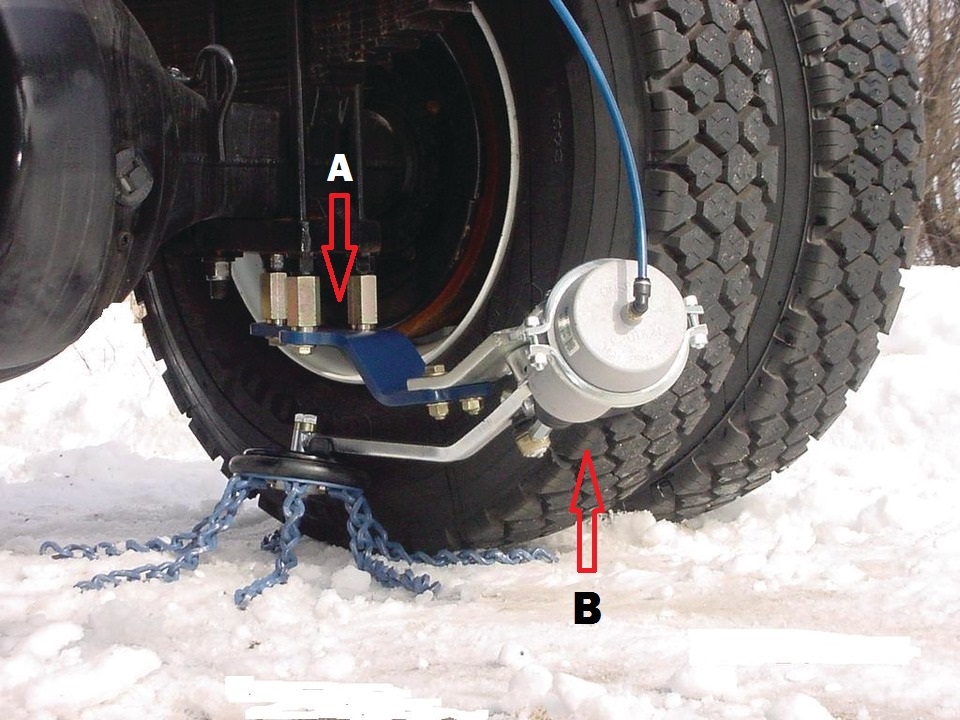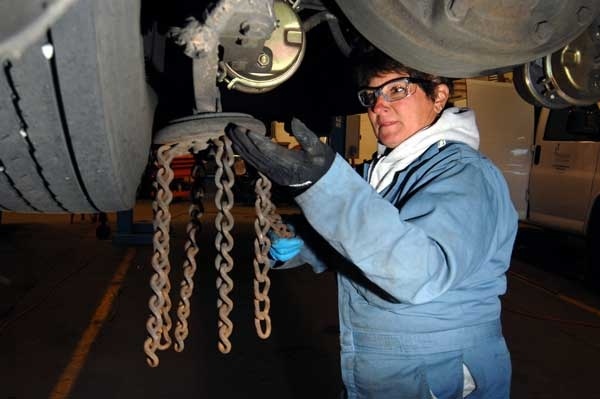Through advances in technology, vehicles of today have come a long way. Emergency vehicle response time is faster, modern plow trucks maintain roads more effectively, and semis, buses and cars all use devices that provide the driver, and those around them, with a safer means of transportation. Ultimately, however, it is the driver who needs to understand how to maximize all this technology in order to take advantage of its potential.
Onspot is no different.
The same holds true for the Onspot automatic tire chain system. For the driver to maximize the benefits from the system, they have to understand how to properly maintain and operate the system. The most effective way to maintain the Onspot system is to remove it from the chassis during the months when it will not see use. At first, this may sound difficult, but it is actually an easy process. The two main parts (see picture below) of the Onspot system consist of the (A.) mounting brackets and the (B.) chain units.

In this case, you are simply looking to remove the left and right-side chain units, leaving the mounting brackets and associated hardware attached to the vehicle chassis. Once the chain units are off the vehicle, you have a great opportunity to "bench" the system, assessing the chain units and making any necessary adjustments and repairs. Afterwards, the chain units can then be stored for the next season. This is by far the most effective way to maintain the Onspot system.
There is no off season.
For some, the spring/summer season may be too short or they are always traveling in a variety of weather that requires them to leave the chain system on the vehicle year round. In this case, the most effective way to maintain the Onspot system is to make sure it is serviced every time preventative maintenance (PM) is done on the vehicle.

All fittings should be greased, chain wheels checked for wear, and hardware torqued to the proper specifications. Last, but certainly not least, in terms of maximizing operation, is to "exercise" or activate the system.
No snow and ice are present.
Ideally, the chain units should be deployed on a snow or ice covered surface, however, when exercising the system year round, these conditions will not always be present. Alternatives to snow and ice covered surfaces are hard packed dirt roads, gravel roads, or simply asphalt. When exercising the system in the off season, dirt or gravel roads always work best as you can see the chain link spread and pattern marked in the dirt/gravel, which is a great indicator of how the system is operating.

If a dirt/gravel road is not available, an asphalt surface will work as well. The Onspot system uses through hardened steel chain, so it can withstand being engaged on this harder surface. The key is to exercise the system keeping it in tune for when it is needed.
The wheels must be moving.
Whether you are going in forward or in reverse, it is important that the wheels are moving when engaging the Onspot system. Essentially, the rubber surface of the chain wheel makes contact at the tire side wall bulge. Therefore, it is critical that the wheels are turning in order to allow the chains to slip under the tire and provide traction. Anticipating when to engage the system is also critical to maximize the operation of the chain units. The system should always be engaged before you get into a situation that involves slippery road conditions. Some tips for maximum operation of the Onspot system in certain situations are as follows:
- Hills:
When traveling up or down ice/snow covered hills always engage the chains prior to the hill.
- Driveways/Side streets:
When pulling onto unplowed driveways, side streets, or exit ramps from cleared roads always engage the chains prior to entering these areas.
- Docks/Loading yards:
Chain engagement prior to entering the yard is always most effective as the chains will already be under the tires regardless of whether you are moving in forward or reverse. Additionally, once parked at the dock continue to leave the chains engaged as they will keep the hot surface of the tires from sinking into the snow. Then, simply pull away from the dock riding on the chains when leaving.
For additional information on how to operate and maintain your Onspot system click on the following link:


